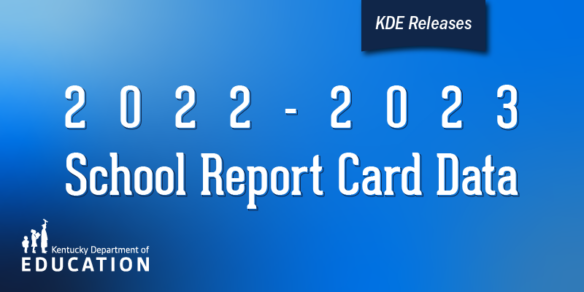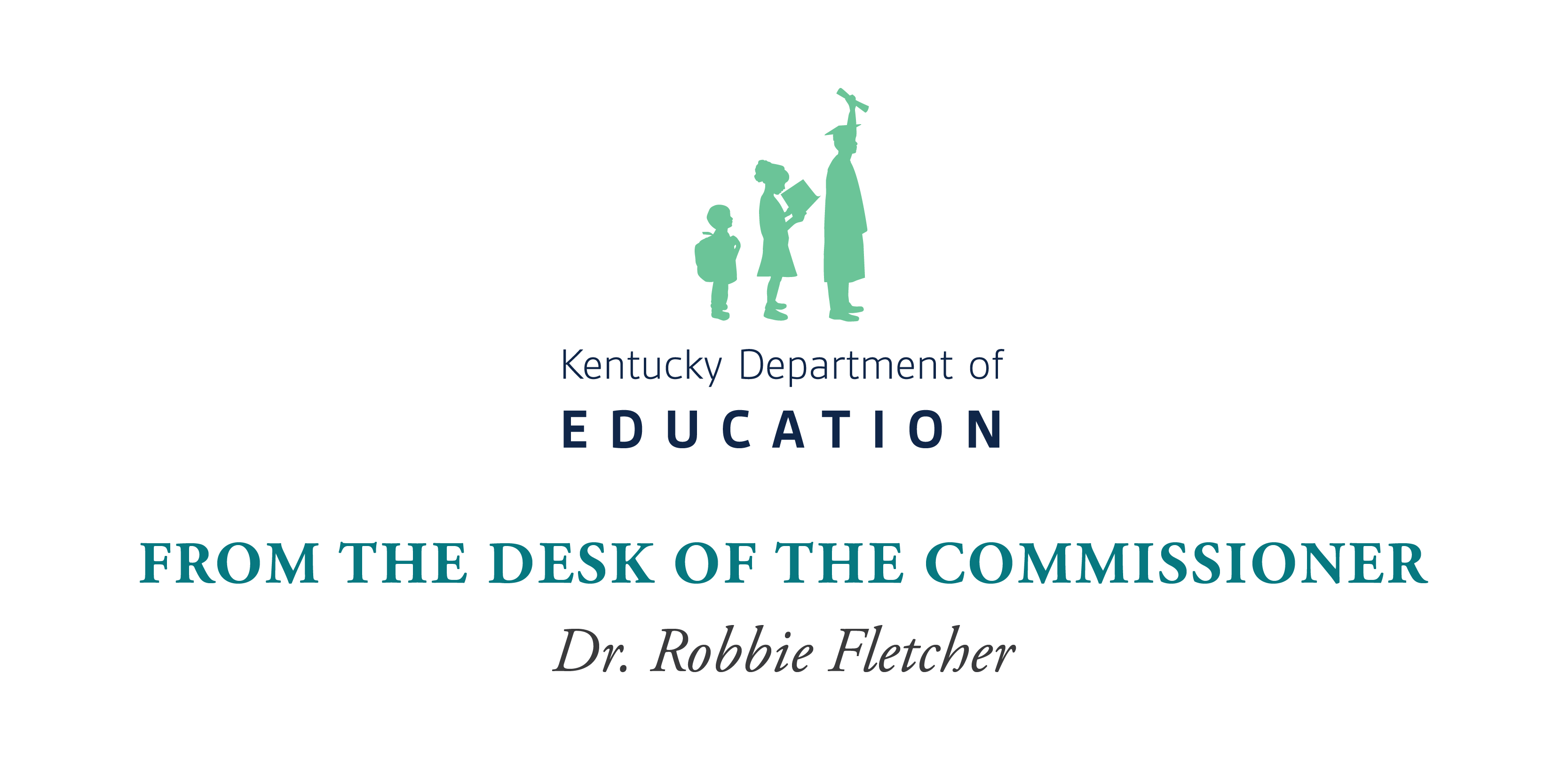 (FRANKFORT, KY) – The Kentucky Department of Education (KDE) released the annual Kentucky School Report Card for the 2022-2023 academic year on Oct. 31 as required by state statute and the federal Every Student Succeeds Act.
(FRANKFORT, KY) – The Kentucky Department of Education (KDE) released the annual Kentucky School Report Card for the 2022-2023 academic year on Oct. 31 as required by state statute and the federal Every Student Succeeds Act.
“The data in this year’s Kentucky School Report Card paints a complex picture for the Commonwealth’s education community to address,” said Kentucky Interim Commissioner of Education Robin Fields Kinney. “We see progress in some areas, especially at the elementary school level, but there is still a lot of work left to be done.”
Kinney added: “We must not underestimate how much of an impact the COVID-19 pandemic has had on our children. We know that changes in the way instruction was delivered from 2020 to 2022 had an impact on student learning, despite the tremendous efforts of Kentucky educators and parents to remediate those impacts.”
“This will be a multi-year recovery period that requires all of us to think differently about how we are educating our students,” she said. “KDE and our local districts and schools have been proactive in getting students back on track. Federal, state and local funds have been dedicated to address learning loss. We remain committed to supporting our districts and teachers on this journey.”
Kentucky received more than $2 billion in federal funding through the American Rescue Plan (ARP) Act to help accelerate learning and get additional support to districts and the students who need it the most. Many schools across the Commonwealth expanded tutoring, added more summer learning programs and enacted other strategies to boost recovery efforts.
“It is going to take time,” Kinney said. “It’s important for all of us to use this data responsibly to help inform parents and families about their students’ schools and to allow local leaders to target resources to communities and schools that need them most.
Kentucky saw improvement with students deemed proficient or distinguished in reading at the elementary school level. Kinney said the metrics show Kentucky school districts have already made strides with early literacy with recent initiatives like Language Essentials for Teachers of Reading and Spelling (LETRS) training through the Kentucky Reading Academies.
“Kentucky’s educational challenges require thorough solutions, and even though it may take some time to see the fruits of our labor, our children will be better for the efforts we’re making today,” said Kinney.
The number of elementary school students deemed proficient or distinguished in math, science and social studies increased, with smaller gains made at the middle and high school levels.
KDE has been working diligently to help schools address other areas where assessment data shows room for improvement:
- The Reading and Writing Instructional Resources Consumer Guide and the Mathematics Instructional Resource Consumer Guide help districts select high-quality instructional resources;
- The Standards Implementation Guides help schools and districts identify available resources to help with standards implementation;
- Evidence-Based Instructional Practices help provide equitable learning environments with a viable curriculum that is aligned to the Kentucky Academic Standards (KAS); and
- Standards Family Guides help families understand the content of each grade level’s standards.
The Kentucky School Report Card has new features for the 2022-2023 academic year results because of the continued implementation of Senate Bill 158 (2020). The legislation established “status” and “change” as ways to evaluate state indicators, and this will be the first year where change is reported.
In Kentucky’s accountability system, schools are measured on a combination of academic and school-quality indicators and measures. Using data from the 2022-2023 school year, Kentucky’s accountability system provides a color-coded overall performance rating for each school, district and the state by level, ranging from red (lowest) to blue (highest).
“Status” represents a school’s performance on a state indicator for the current year, while “change” represents the school’s performance on the indicator for the current year compared with the previous year. Status and change combine to provide a performance rating for each state indicator.
The overall performance rating color is based on a score that is determined by combining data from all available indicators. The overall score is used to determine the state’s lowest-performing schools by grade level, as required federally.
With the introduction of change into the system, comparisons cannot be made to accountability data from 2022. Although the color-coded dials represent school accountability in 2022 and 2023, the system is vastly different with the inclusion of the change score and should not be compared. Comparisons can, however, be made in assessment performance and in accountability between schools at each grade level (i.e., elementary to elementary) within the same year.
Indicator ratings also cannot be combined to determine the overall ratings. The overall performance rating color is based on cut scores recommended by the Kentucky Accountability Standards Setting Committee, not the combination of indicator ratings.
The Kentucky School Report Card catalogs other datasets, including chronic absenteeism. KDE defines chronic absenteeism as a student attending 90% or less of their full-time equivalency, which is a calculation for how much time a student should spend in class.
In the 2022-2023 academic year, 198,524 students in Kentucky qualified as chronically absent, which was 29.8% of students.
“We must address the issue of chronically absent students, as their continued absence hinders their educational progress and overall well-being,” Kinney said. “Every child deserves the opportunity for consistent attendance and a chance to thrive in the classroom. It is crucial that we work together and find solutions to combat chronic absenteeism.”
Attendance data from the 2020-2021 and 2021-2022 school years is not comparable due to districts not collecting traditional attendance because of COVID-19. Attendance data was not published for the 2019-2020 school year due to the initial COVID-19 outbreak. In the 2018-2019 school year, 119,581 students were considered chronically absent, which was 17.8% of Kentucky students.
This year’s Kentucky School Report Card also includes data on school behavioral incidents, dropout and retention rates and access to technology, among many other sets of information. School finance information will be released in the spring of 2024.
Academic Performance/Assessment Results
Kentucky public school students in grades 3-8, 10 and 11 took assessments called the Kentucky Summative Assessments (KSA) and the Alternate Kentucky Summative Assessments (AKSA) in reading, mathematics, social studies, science, editing and mechanics and on-demand writing. Students take reading and mathematics assessments annually in grades 3 through 8, and in grade 10. Other subjects are assessed once per grade level, with social studies and editing and mechanics and on-demand writing assessed in grades 5, 8 and 11. Science continued to be assessed in grades 4, 7 and 11.
All data for the 2022-2023 assessment and accountability reporting are included in a color-coded dashboard publicly available on the Kentucky School Report Card. To search for a school or district’s results, type the name of the school or district in the search bar on the homepage. To search for results for all of Kentucky, enter “Kentucky” in the search bar.
Assessment results are just one of several strategies KDE is conducting to evaluate school recovery from COVID-19 and create a more robust and equitable education system. It is important to remember that in any year, a single test score does not provide a complete or precise measure of student achievement.
Families are encouraged to consider their student’s results within the context of the variety of potential learning disruptions they may have encountered, including the COVID-19 pandemic. Families will receive an individual student report from their child’s school district that details their performance on the KSA or AKSA, later this fall.
The assessment and accountability results are additional information about areas where there has been positive movement or where students and schools need support. This supports the data teachers gain through their daily interaction with students and a collection of performance information from a variety of opportunities students have to show what they know and can do. Families can keep up with the day-to-day performance of their students using the Infinite Campus mobile app or web portal.
More data can be found in the media briefing packet located on the KDE Communications webpage.
Average Kentucky ACT Scores
| Year | English | Math | Reading | Science | Composite |
|---|---|---|---|---|---|
| 2019 | 19.5 | 19.2 | 20.5 | 19.6 | 19.8 |
| 2020 | 18.9 | 19.0 | 20.1 | 19.6 | 19.5 |
| 2021 | 18.7 | 18.8 | 19.7 | 19.3 | 19.2 |
| 2022 | 17.8 | 18.0 | 19.2 | 18.7 | 18.6 |
| 2023 | 18.1 | 18.1 | 19.3 | 18.8 | 18.7 |
2022-2023 Overall Performance Ratings - Districts
The tables below contain the percentage of students performing at each performance level on KSA and AKSA tests. The goal is to move all students to a higher performance category and ultimately to the proficient performance level or above. Student performance on these tests serves as the basis for several indicators in Kentucky’s accountability system.
Additional state data, including all indicators and breakdowns by student group for each subject and performance level, can be viewed on the Kentucky School Report Card.
Elementary School Performance Level Percentages by Content Area
Middle School Performance Level Percentages by Content
High School Performance Level Percentages by Content Area
Graduation Rate
The graduation rate indicator is consistent with previous accountability systems. Using the federal definition, the percentage of students earning a high school diploma is compared to the cohort of students starting in grade 9.
Kentucky uses a 4-year adjusted cohort rate and an extended 5-year adjusted cohort in accountability, which recognizes the persistence of students and educators in completing the requirements for a Kentucky high school diploma. The 4-year and 5-year rates are averaged for accountability reporting.
4-Year Graduation Rate Percentage Trends
5-Year Graduation Rate Trends
ACT
Since 2008, all of Kentucky’s public school juniors have participated in the ACT, which assesses English, mathematics, reading and science abilities and is scored on a scale of 1 to 36. The cost of the exam is paid for by state funds.
ACT Subject Area Scores Kentucky Public School Juniors
Federal Classifications: CSI, TSI and ATSI
Comprehensive Support and Improvement (CSI), Targeted Support and Improvement (TSI) and Additional Targeted Support and Improvement (ATSI) are federally mandated school identifications that are based on the overall school score that is generated by the state accountability system.
Beginning with the 2022-2023 school year, schools will be identified for CSI and ATSI every three years. The next identification of CSI I, CSI II and ATSI will be in 2025.
CSI status schools were identified based on three criteria: If the school is in the bottom 5% of all schools based on the overall school score; if they have a graduation rate below 80%; or if they fell under ATSI status for at least three years.
TSI schools are those who have a student group performing at or below the bottom 5% of all schools. TSI schools will be identified this fall based on 2022-2023 data.
During the 2022-2023 school year, 23 schools previously identified as CSI have exited this status. Additionally, 185 schools previously identified as TSI have exited as well.
“What these schools have done, improving their status through extraordinary conditions the past few years, is remarkable,” said Kinney. “A considerable amount of work remains to ensure all students demonstrate proficiency on the state assessments, but it is critical to acknowledge the dedication and commitment of our educators through Kentucky.”
Federal Classifications, 2023
*CSI Schools are not newly identified for 2023, but were previously identified and did not meet exit criteria.**Two schools are identified through CSI III criteria.
*CSI schools are not newly identified for 2023, but were previously identified and did not meet exit criteria.
**Two (2) schools are identified through CSI III criteria.




Leave A Comment